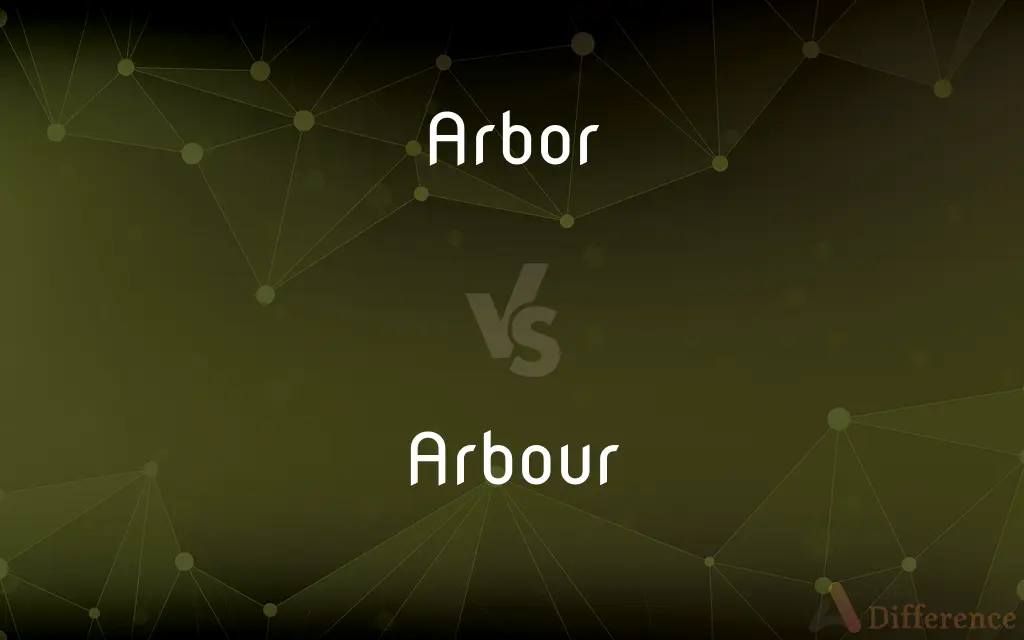Arbor vs. Arbour — What's the Difference?
Edited by Tayyaba Rehman — By Urooj Arif — Updated on April 18, 2024
Arbor refers to a garden structure supporting climbing plants, while arbour is simply the British spelling of the same word.

Difference Between Arbor and Arbour
Table of Contents
ADVERTISEMENT
Key Differences
Arbor is commonly used in American English to describe a framework that supports vines or other climbing plants, often found in gardens or park settings. Whereas, arbour is the British English spelling for the same structure, emphasizing the regional linguistic differences.
An arbor is typically made of wood or metal and serves both a functional and decorative purpose, providing shade and a scenic point of interest. On the other hand, an arbour can also include seating beneath the lattice work, enhancing its utility as a restful garden nook.
Arbors are often associated with romantic and picturesque garden landscapes in American cultural contexts. Meanwhile, in British contexts, arbours are similarly evoked in literature and garden design, reflecting the shared cultural appreciation despite the spelling variation.
In terms of usage, "arbor" appears frequently in American garden manuals and landscaping literature. In contrast, "arbour" is more commonly found in British publications and garden design discussions, underlining the adaptability of language in different English-speaking regions.
While arbors can be simple or elaborate in design, based on the aesthetic and functional requirements of the garden, arbours follow the same versatility, proving that the difference in spelling does not affect the structure’s variety and adaptability.
ADVERTISEMENT
Comparison Chart
Spelling
Arbor
Arbour
Pronunciation
/ˈɑrbər/
/ˈɑːbə(r)/
Usage Context
American English
British English
Literature
Appears in American garden texts
Featured in British garden texts
Design Variety
Ranges from simple to elaborate
Similarly varies from simple to elaborate
Compare with Definitions
Arbor
An arch or structure made of leaves and branches.
The floral arbor at the wedding was stunning.
Arbour
A shady garden alcove with sides and a roof formed by trees or climbing plants.
They rested in the arbour during the afternoon.
Arbor
A shaded area in a garden covered with climbing plants.
We enjoyed lunch under the grape arbor.
Arbour
An architectural element in classic British gardens.
The old estate had a beautifully restored arbour.
Arbor
A framework that supports climbing plants.
They built a wooden arbor for the new vineyard.
Arbour
The British spelling for a structure that supports plants.
The rose arbour was in full bloom.
Arbor
A garden feature that can be decorative or functional.
Their backyard arbor is the centerpiece of the annual garden show.
Arbour
A focal point in a landscape design.
The new arbour will be the highlight of our redesigned garden.
Arbor
A peaceful sitting area in a garden.
She read her book in the quiet of the garden arbor.
Arbour
A restful place in a British garden.
Grandpa loves to nap in his garden arbour.
Arbor
A shady resting place in a garden or park, often made of latticework on which plants such as climbing shrubs or vines are grown.
Arbour
Variant of arbor1.
Arbor
An axis or shaft supporting a rotating part on a lathe.
Arbour
Standard spelling of arbor
Arbor
A bar for supporting cutting tools.
Arbour
A framework that supports climbing plants;
The arbor provided a shady resting place in the park
Arbor
A spindle of a wheel, as in watches and clocks.
Arbor
Pl. ar·bo·res (ärbə-rēz′) A tree, as opposed to a shrub.
Arbor
A shady sitting place or pergola usually in a park or garden, surrounded by climbing shrubs, vines or other vegetation.
Arbor
A grove of trees.
Arbor
An axis or shaft supporting a rotating part on a lathe.
Arbor
A bar for supporting cutting tools.
Arbor
A spindle of a wheel.
Arbor
A kind of latticework formed of, or covered with, vines, branches of trees, or other plants, for shade; a bower.
Arbor
A tree, as distinguished from a shrub.
Arbor
An axle or spindle of a wheel or opinion.
Arbor
Tree (as opposed to shrub)
Arbor
Any of various rotating shafts that serve as axes for larger rotating parts
Arbor
A framework that supports climbing plants;
The arbor provided a shady resting place in the park
Common Curiosities
What is an arbor?
An arbor is a structure in a garden designed to support climbing plants and provide shade.
What materials are used to build an arbor?
Arbors can be made from wood, metal, or other durable materials.
Are arbors found only in private gardens?
No, arbors are also common in public parks and community gardens.
How do you spell arbor in British English?
In British English, arbor is spelled as arbour.
What is an arbour in gardening?
An arbour is a garden structure that provides a shaded sitting area and supports climbing plants.
Is there any functional difference between an arbor and an arbour?
No, the function is the same; the difference is mainly in spelling.
What is the cultural significance of arbors in garden design?
Arbors have a romantic connotation and are often associated with tranquil and picturesque garden scenes.
Can an arbor be used for functions other than supporting plants?
Yes, an arbor can also provide a shaded seating area or serve as a decorative element in a garden.
How do arbours enhance a garden's aesthetics?
Arbours add vertical interest and can serve as an architectural focal point in garden design.
Can arbours have seats?
Yes, many arbours include built-in seating.
Share Your Discovery

Previous Comparison
Book vs. Signature
Next Comparison
Cancel vs. ContinueAuthor Spotlight
Written by
Urooj ArifUrooj is a skilled content writer at Ask Difference, known for her exceptional ability to simplify complex topics into engaging and informative content. With a passion for research and a flair for clear, concise writing, she consistently delivers articles that resonate with our diverse audience.
Edited by
Tayyaba RehmanTayyaba Rehman is a distinguished writer, currently serving as a primary contributor to askdifference.com. As a researcher in semantics and etymology, Tayyaba's passion for the complexity of languages and their distinctions has found a perfect home on the platform. Tayyaba delves into the intricacies of language, distinguishing between commonly confused words and phrases, thereby providing clarity for readers worldwide.















































